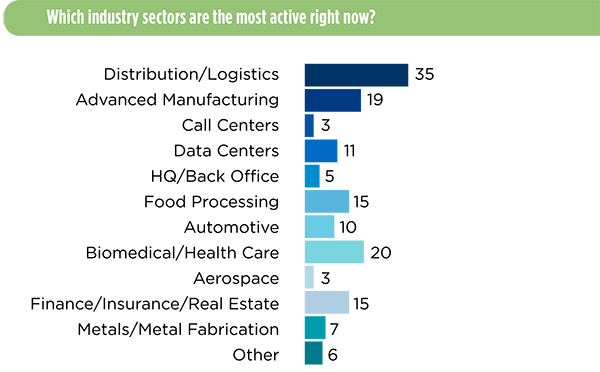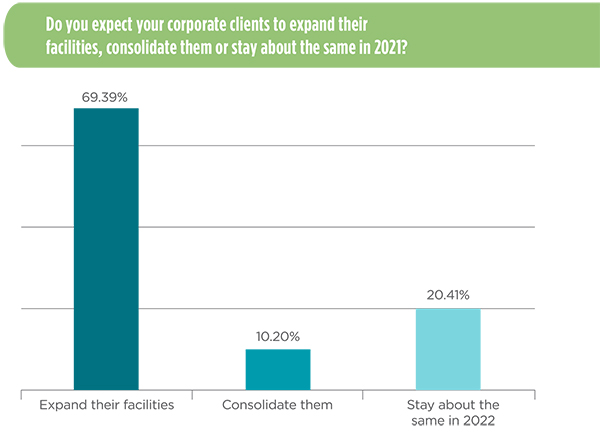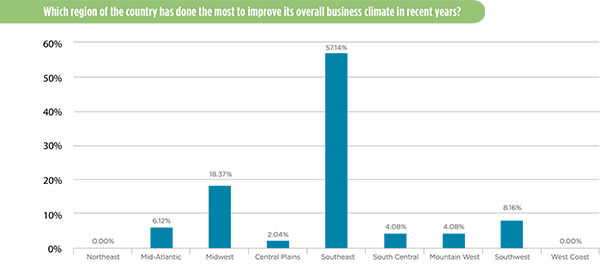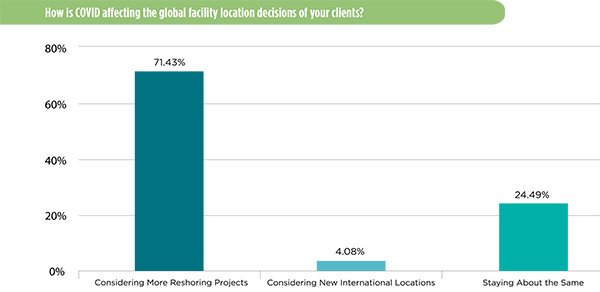As the world enters its third year of COVID-19, site selectors are doubling down on predictions they made a year ago. From reshoring and supply-chain tightening to remote working and worker shortages, site selectors are telling us that the trends exacerbated by the global pandemic will become even more pronounced in 2022.
When we surveyed national site selection consulting firms in November of 2020, the world had just entered its ninth month of the coronavirus pandemic. Site selectors told us then that their clients were already regrouping by redirecting resources to support reshoring efforts, relocation of workplaces to satellite facilities, and remote working.
When we surveyed these same consultants again in November of 2021, their responses reflected how entrenched these new realities had become. The big takeaways from our annual Site Selectors Survey this time were as follows:
- Distribution and logistics projects will again dominate the headlines in 2022.
- Sunbelt states maintained their status as the most favored business climates in America.
- Most corporate clients are expected to expand their facilities sometime this year.
- Reshoring projects are here to stay for the foreseeable future.
- Suburban and rural communities will benefit as more employers look outside of large central cities to establish new workplace hubs.
- Remote working has become a permanent part of the new workplace landscape.
- Governmental mismanagement continues to be the main barrier to getting deals done.


Distribution Is King
Long lines at the big box store may have reappeared on Black Friday, but those lines pale in comparison to the number of people lining up to order goods online. Over 230 million people in the U.S. purchased goods online in 2021, and that number is rising each year.
All these purchased goods must be shipped somewhere, and that logistics operation requires massive growth in distribution facilities year in and year out. Seventy percent of site selectors polled by Site Selection in November 2021 said that distribution and logistics projects were the most active industry sector right now. The next most active sectors, according to the consultants, were biomedical and health care, advanced manufacturing, food processing, and finance/insurance/real estate.
"Trend is toward suburban or smaller metros with reasonably good labor markets and available buildings.”
— Anonymous Respondent to Site Selectors Survey

Go South, Young Man
When asked to name which states had done the most to improve their overall business climate in recent years, most of the 50 total respondents named a Sunbelt state. The most often cited states, in order, were Florida and Tennessee (tied for first with 14 votes each); Texas (13); North Carolina (10); Georgia (9); and South Carolina (8). The best Midwestern finishers were Ohio and Missouri, with 6 votes apiece. No other state received more than 4 votes. Several big states did not receive a single vote. Among them were California, New York and Illinois.
Similarly, we asked consultants to tell us which region of the country had done the most to improve its business climate, and 57% chose the Southeast. The Midwest placed second with 18%, followed by the Southwest with 8% and the Mid-Atlantic with 6%.
Expanding, But Closer to Home
More than 69% of the respondents said they expect their corporate clients to expand their facilities in 2022 — up from 36.5% one year ago. Just 10% predicted that their clients would consolidate in 2022, while 21% said they would stay about the same.
Companies that are expanding are increasingly looking homeward, according to consultants, as 71.5% of respondents said their clients were now considering more reshoring projects, versus just 4.1% who said their clients were considering new international locations. Some 25% said their clients would stay about the same in 2022. For every one respondent who said clients were considering new international locations, 17 said clients were reshoring.
Welcome Back to the Burbs
Another huge dichotomy was revealed when we asked site selectors how COVID-19 was impacting the domestic locations decisions of their clients. Nearly half (46.94%) said their clients were considering moving from central cities to suburbs and rural areas, while just 6.12% said their clients were considering consolidating operations in central cities. The remaining 46.94% said their clients would stay about the same.
A couple of site consultants shared their thoughts on why this trend was happening. One said, “Social unrest, crime and spiraling taxes are compounding the pace of migration away from central cities.” Another wrote: “Trend is toward suburban or smaller metros with reasonably good labor markets and available buildings.”

Saying Goodbye to the Office
The trend toward more remote workers picked up pace in 2021, as 85% of respondents said that remote working had impacted their clients site selection decisions, compared to just 15% who said it had no effect. Those numbers changed only slightly from 2020, when 83% said that remote work had affected the site decisions and 17% said it had no effect.
When asked if the trend toward more remote work would continue even after the pandemic subsides, 59% said yes, 20% said no, and 20% said they did not know. Several weighed in with additional thoughts:
- “Most companies will adopt a hybrid model for office work.”
- “For autonomous tasks, yes. Where collaboration is required, we are seeing more of an urgency to get back to the office environment.”
- “Remote work is having a significant impact on head office relocations, shared services projects and contact center moves.
Give Me Certainty, or Give Me No Deal
Finally, we asked the consultants to name the most common deal-killers. Just as they did last year, the site selectors told us that governmental mismanagement of projects was by far the biggest cause of deals going south. Many spoke plainly when naming culprits:
- “Municipalities that refuse to listen to the end user or work with developers to bridge the communication gap.”
- “Poor or incomplete job preparation. Many communities have taken initial steps. Relatively few have thought through what business and industrial prospects must go through to make siting decisions.”
- “Lack of local cooperation.”
- “Poor attitude from city hall.”
- “Cumbersome, slow and unclear process and procedures when dealing with state and local economic development officials.”
- “Delay of permitting.”
- “Over-regulation by government.”
- “Red tape and unresponsive government.”
- “Inability to meet the need for time to market.”

